Google Ads is a powerhouse when it comes to driving traffic, generating leads, and increasing conversions.
But to actually create Google Ads that convert, it takes a little bit more than just setting up the campaign.
It involves a strategy, attention to detail, and continuous optimization for your ads to reach the target audience.
Whether you’re a beginner or someone looking to refine your strategy, this guide will walk you through every step of the process.
Let’s dive into the fundamentals of Google Ads and how you can harness its full potential to grow your business.
- Understanding the Basics of Google Ads
- Setting Up Your Google Ads Campaign
- Crafting Ads That Drive Conversions
- Optimizing Google Ads for Better Performance
- Scaling and Sustaining Google Ads Success
- Your Complete Guide to Creating Google Ads That Convert
- Frequently Asked Questions About Creating Google Ads That Convert
Understanding the Basics of Google Ads
Before diving into campaign creation, it’s essential to understand the foundational elements of Google Ads.
These basics set the stage for a successful advertising journey and equip you with the knowledge to make informed decisions.

Illustrating the global reach and user engagement of Google Ads.
What Are Google Ads and Why Use Them?
Google Ads is an online advertising platform where businesses can place their ads on Google search engine results pages, partner websites, and other digital areas.
Through Google Ads, one can reach an audience by targeting people’s search behavior, demographicsStatistical characteristics of a population, such as age, gender, and income., and interests.
- Wide Reach: Because billions of searches are conducted each day, Google Ads allow you to reach a wide audience.
- Measurable Outcomes: Monitor metrics such as impressions, clicks, and conversions to determine your return on investment.
- Flexible Budgeting: Establish daily budgets and bids that work in harmony with your marketing objectives.
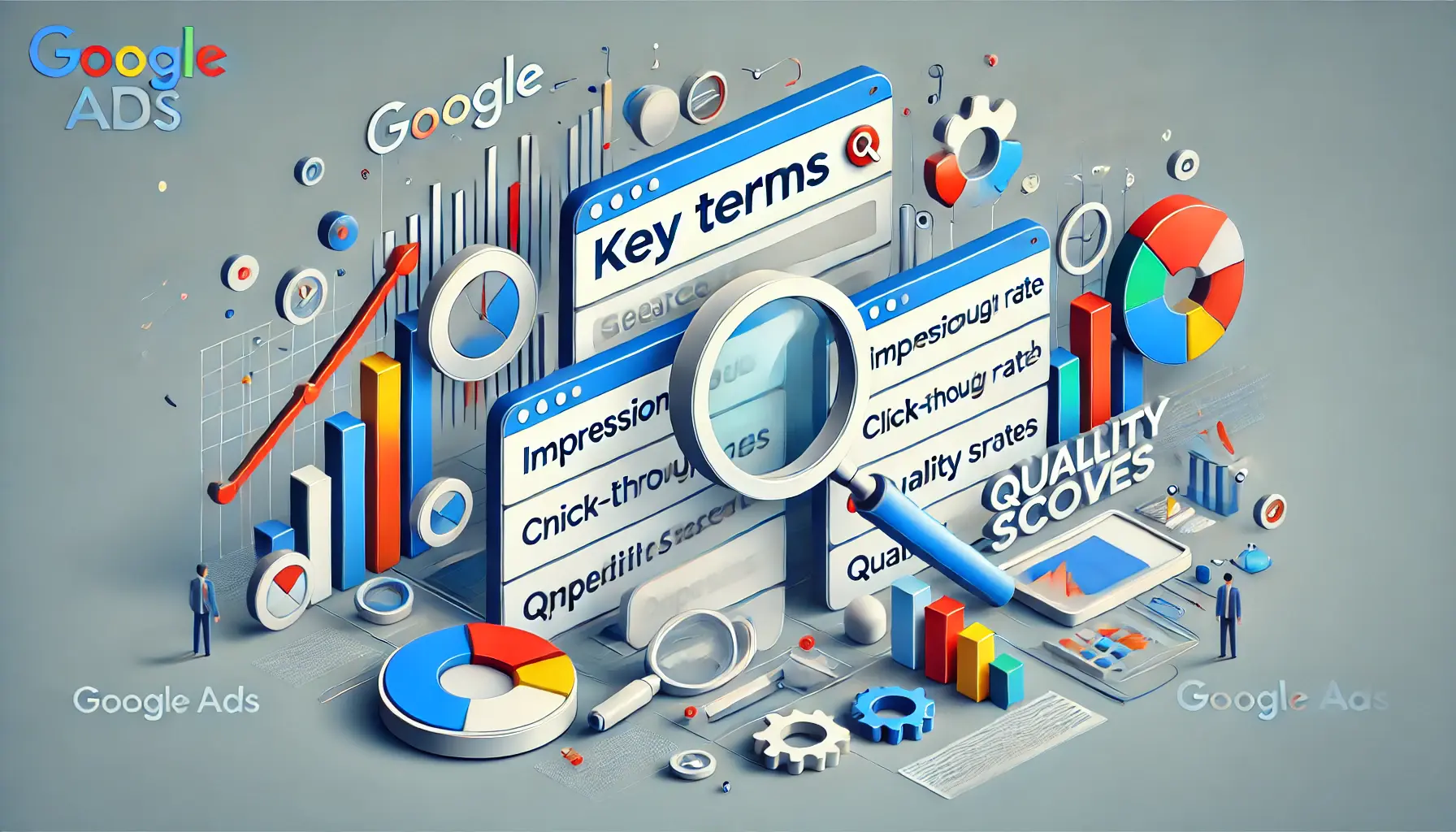
Visualizing the essential keywords and concepts in Google Ads.
Key Words to Know When Starting with Google Ads
To use the Google Ads platform effectively, understand the following key words and what they mean:
- Impressions: This is the number of times your ad appears.
- CTR (Click-Through Rate): The percentage of users who click your ad after seeing it.
- Keywords: Words or phrases that trigger your ads when users search for them.
- Quality Score: A metric that assesses the relevance and quality of your ads and landing pages.
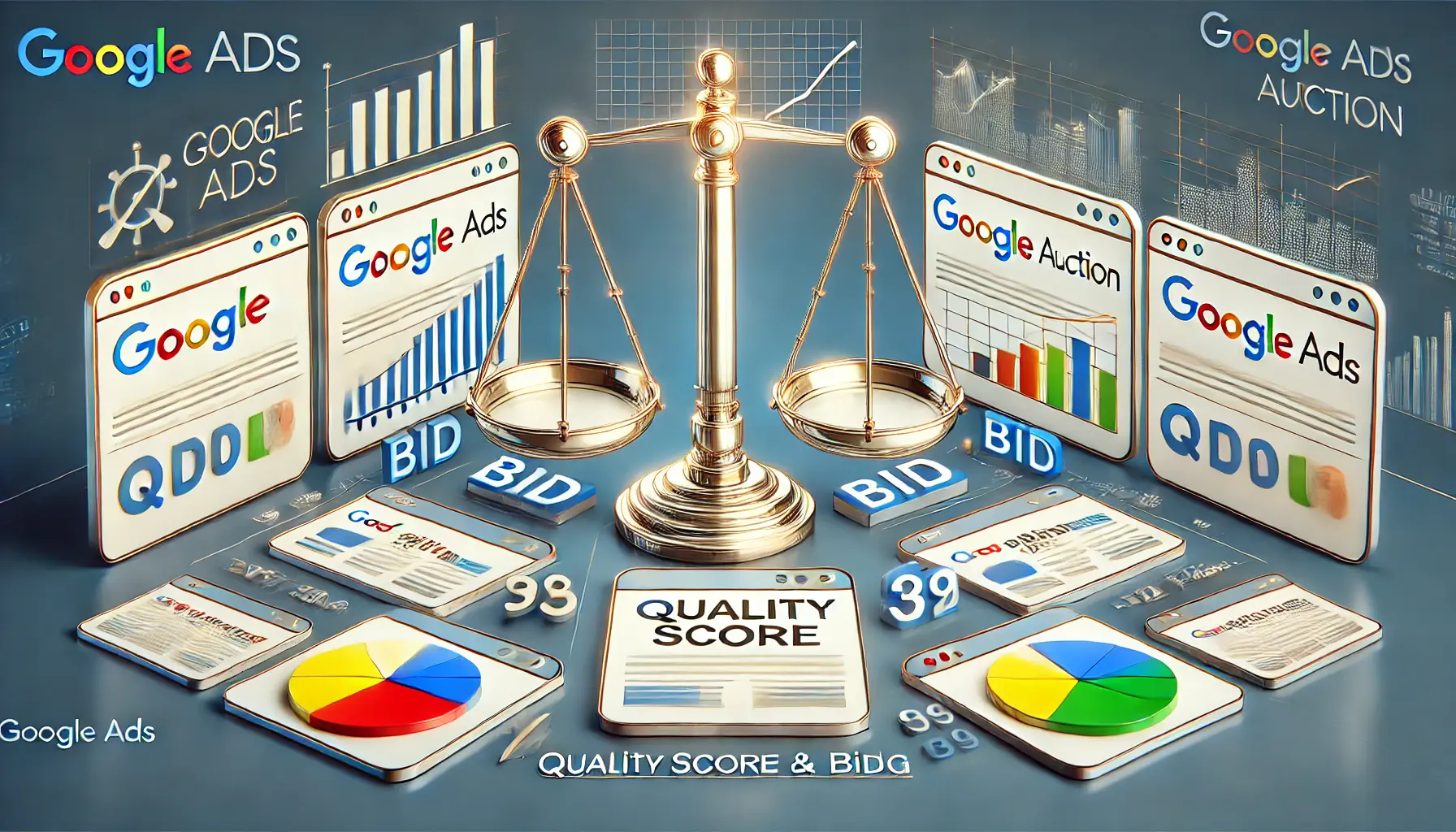
Depicting the mechanics of Google Ads auctions with symbolic elements.
How Google Ads Auctions Work
Google Ads works on an auction system wherein everybody bids for ad placement.
This is not all about how much you bid; the auction also considers:
- Your Bid: The amount you are willing to pay when a click happens.
- Quality Score: High scores can reduce cost and improve ad placement.
- Ad Rank: It is calculated by multiplying your bid with your Quality Score.
By understanding how auctions work, you can optimize your bids and create high-quality ads that maximize your budget.
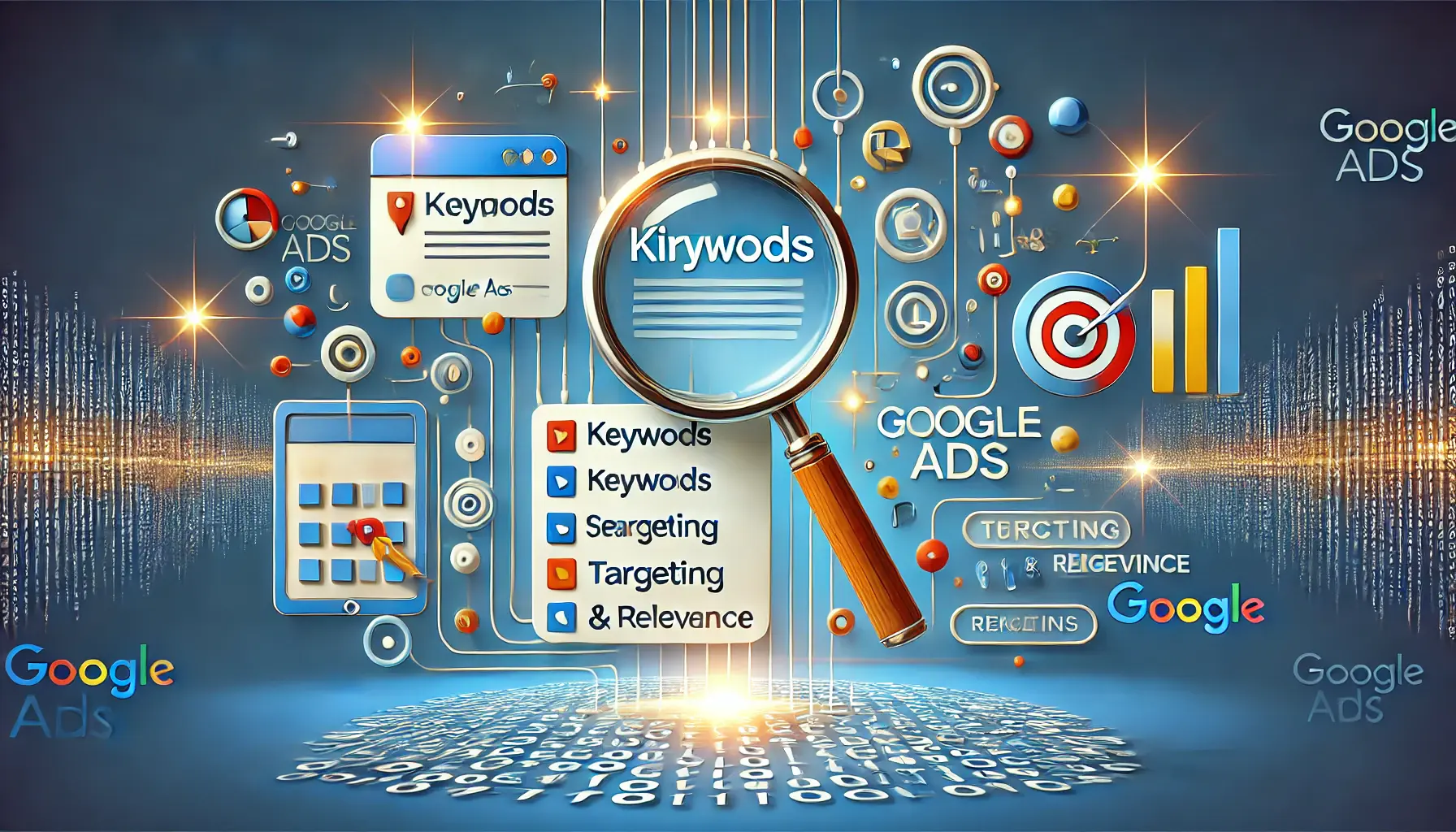
Illustrating the importance of keywords in achieving Google Ads success.
The Role of Keywords in Google Ads Success
Keywords are at the core of every Google Ads campaign.
They connect your ads to users’ search queries, making relevance critical.
Here’s how to choose the right keywords:
- Focus on Intent: Use keywords that align with your target audience’s needs.
- Utilize Tools: Tools such as Google Keyword Planner will help in the identification of high-performing keywords.
- Refine with Match Types: Broad match, phrase match, and exact match give you control over how keywords trigger your ads.
Mastering these basics will ensure that you are well-prepared to create campaigns that deliver measurable results.
Mastering the basics of Google Ads lays the foundation for creating impactful campaigns that achieve your marketing goals.
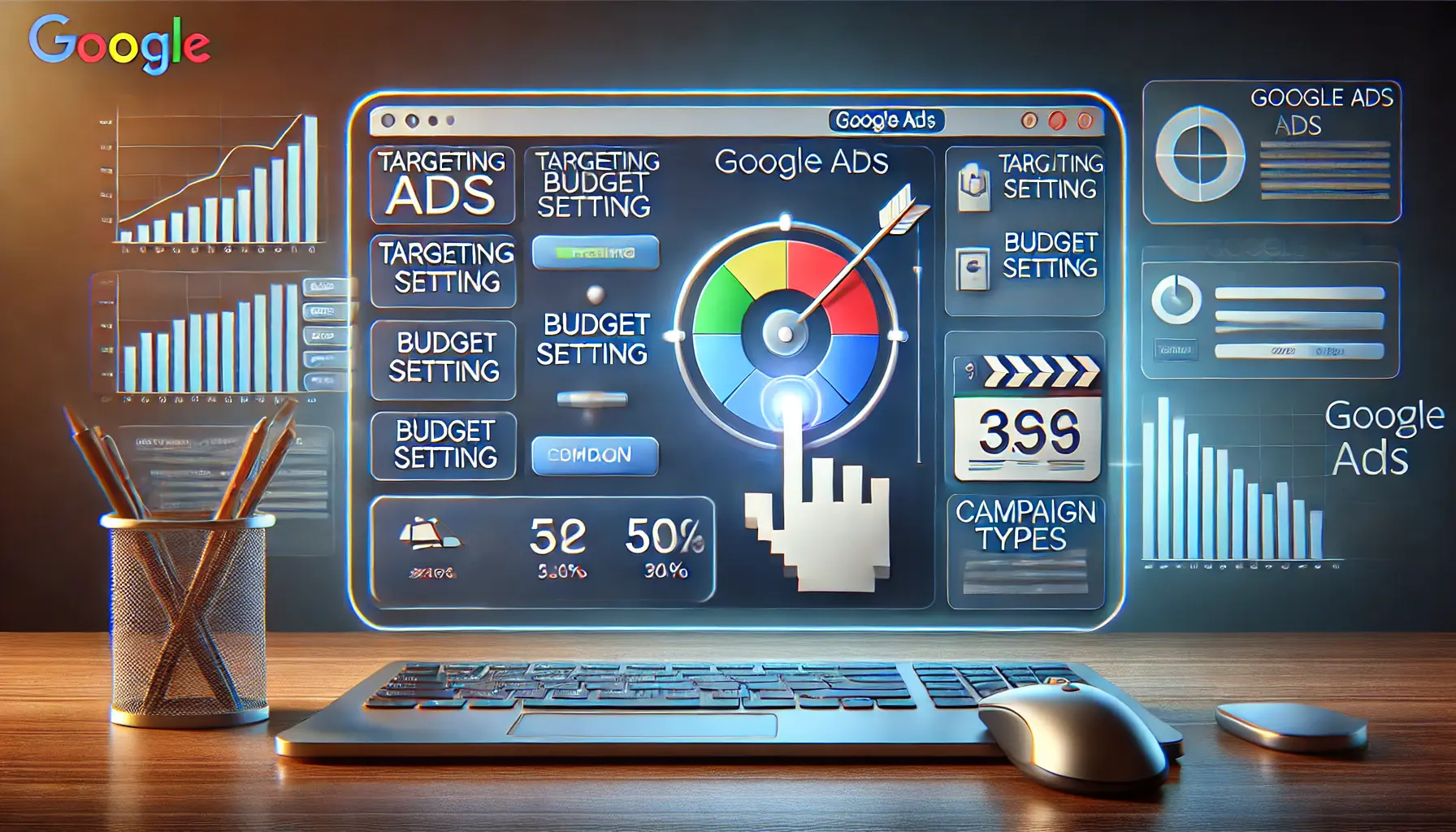
Visualizing the process of setting up a Google Ads campaign.
Setting Up Your Google Ads Campaign
Setting up your Google Ads campaign is the foundation for driving results.
A well-structured campaign ensures your ads reach the right audience at the right time.
By carefully planning and configuring your campaigns, you can optimize for success and maximize your return on investment.
Let’s explore the essential steps and strategies to set up a high-performing Google Ads campaign.

Visualizing the selection of different Google Ads campaign types.
Choosing the Right Campaign Type
Google Ads offers various campaign types tailored to different marketing objectives.
Choosing the right campaign type is crucial for achieving your goals.
Primary options include:
- Search Campaigns: Perfect for sending traffic with text ads in search results.
- Display Campaigns: Visually advertise on partner websites to create brand visibility.
- Shopping Campaigns: Showcase products with images and prices for an e-commerce business.
- Video Campaigns: Engage audiences with video ads on YouTube and other platforms.
- App Campaigns: Promote your app across Google’s network to drive downloads and engagement.
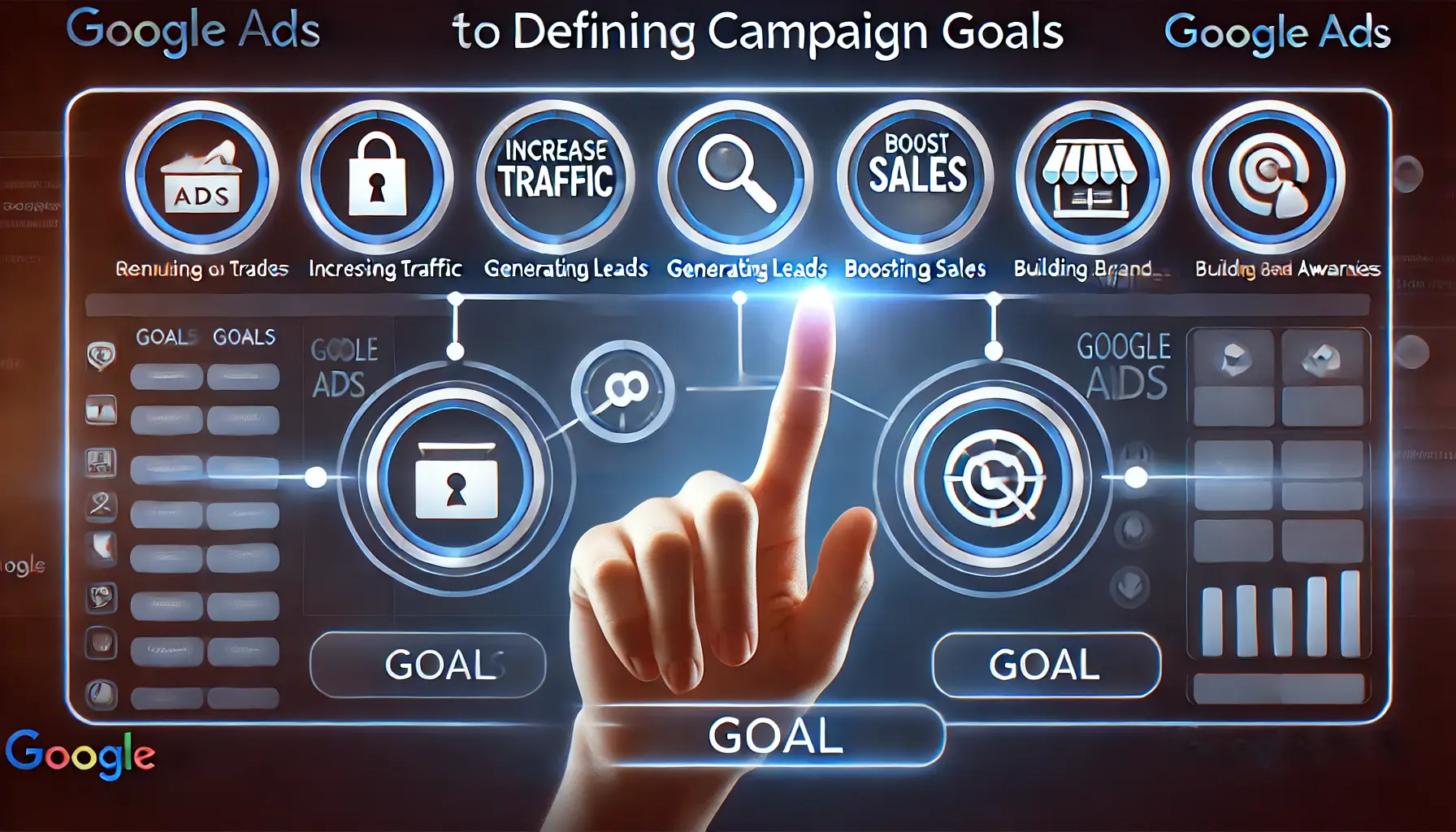
Visualizing the process of setting campaign goals for Google Ads.
How to Define Your Campaign Goals
Clear goals are the cornerstone of a successful Google Ads campaign.
Before launching your campaign, define your objectives.
Common goals include:
- Increasing Website Traffic: Drive more users to your website or landing pages.
- Generating Leads: Capture contact information through forms, sign-ups, or downloads.
- Boosting Sales: Encourage purchases or conversions on your site.
- Building Brand Awareness: Increase visibility and familiarity with your brand.
Google Ads provides tools like goal-based recommendations to help align your campaigns with these objectives.

Visualizing the process of setting a daily budget for Google Ads.
Budgeting for Success: Setting the Right Daily Cap
Determining your budget is important for managing costs and achieving your objectives.
Google Ads allows you to set a daily budget for each campaign.
Here’s how to approach it:
- Start Small: Begin with a conservative budget to test performance and refine your strategy.
- Analyze Performance: Use Google Ads reporting tools to identify high-performing campaigns, then allocate more budget to those campaigns.
- Consider Bidding Strategies: Choose from options like Cost-Per-Click (CPC), Cost-Per-Mille (CPM), or Target ROAS (Return on Ad Spend) based on your goals.

Visualizing the step-by-step process of Google Ads campaign creation.
Step-by-Step Guide to Campaign Creation
Here’s a streamlined process for setting up a Google Ads campaign:
- Sign In to Google Ads: Log in to your Google Ads account and click on “New Campaign.”
- Select Your Goal: Choose from options like Sales, Leads, or Website Traffic.
- Choose Your Campaign Type: Based on your goal, select Search, Display, Shopping, or another type of campaign that suits your business model.
- Set Your Budget and Bidding: Define a daily budget and select a bidding strategy to match your objectives.
- Target Your Audience: Use demographics, locations, and keywords to narrow your audience.
- Create Ad Groups: Organize your ads by themes or products for better relevance to your target audience.
- Write Your Ads: Craft compelling headlines and descriptions to attract clicks.
- Review and Launch: Double-check your settings and launch your campaign.
Following these steps ensures a smooth setup process and lays the groundwork for a successful Google Ads campaign.
A well-structured Google Ads campaign is crucial for reaching the right audience and optimizing your marketing spend effectively.

Visualizing the effectiveness of well-crafted ads in driving conversions.
Crafting Ads That Drive Conversions
Creating Google Ads that convert requires a blend of creativity, strategy, and data-driven decisions.
The right ad copy, format, and targeting can significantly improve your campaign’s performance and return on investment.
In this section, we’ll cover actionable strategies for crafting high-performing ads that captivate your audience and drive meaningful conversions.

Visualizing the creative process of crafting persuasive ad copy.
Writing Compelling Ad Copy That Converts
Ad copy is the heart of your Google Ads campaign; it’s all about capturing attention and driving users to take action.
Here are some tips for writing compelling ad copy:
- Focus on Benefits: Show how the product or service solves a problem or fulfills a need.
- Use Action-Oriented Verbiage: Phrases such as “Sign Up Today” or “Get Started Now” encourage clicks.
- Use Keywords: Incorporate targeted keywords into the text to improve relevance and Quality Score.
- Appeal to Emotions: Use emotions like urgency, curiosity, or exclusivity to drive action.
- Test Headlines: Experiment with multiple headline variants to identify what resonates with your target audience.
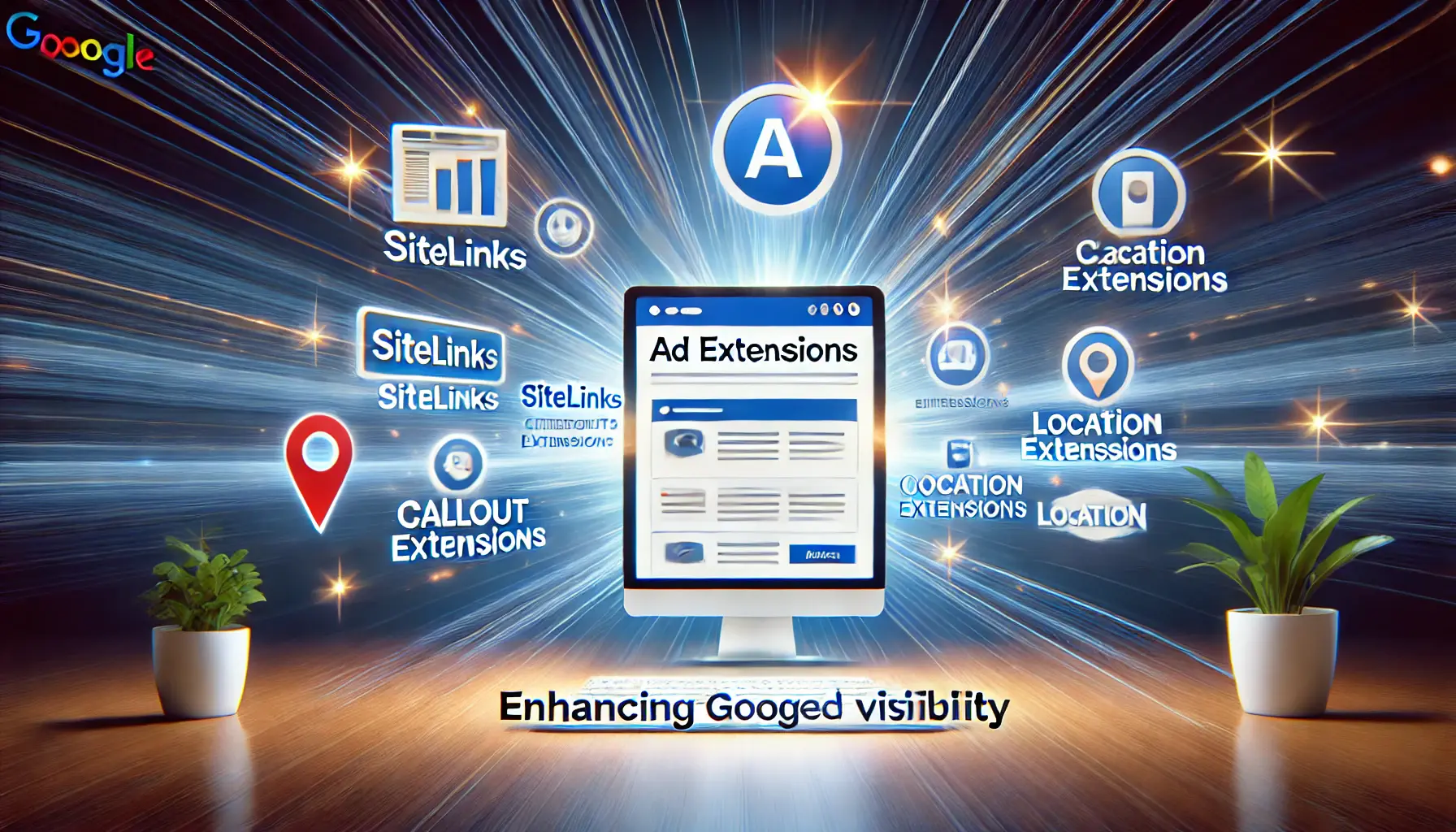
Visualizing the effectiveness of ad extensions in enhancing Google Ads visibility.
Using Ad Extensions to Increase Visibility
Ad extensions are a great way to add more information and context to your ads, making them more visible and engaging.
They increase your ad’s appeal and improve click-through rates.
Popular ad extensions include:
- Sitelink Extensions: Link directly to specific pages on your site, such as product categories or contact forms.
- Callout Extensions: Highlight unique selling points, such as “Free Shipping” or “24/7 Support.”
- Call Extensions: Allow users to call your business directly from the ad, particularly useful for mobile users.
- Location Extensions: Showcase your business address and a map link to attract local customers.
- Price Extensions: Display your products or services along with their prices to set clear expectations.

Visualizing the process of selecting the best keywords for Google Ads campaigns.
How to Choose Keywords – Best Practices
Keywords are crucial in connecting your ads to the right audience.
Selecting the best keywords ensures your ads appear in front of users who are most likely to convert.
Here’s how to choose effectively:
- Use Long-Tail Keywords: Target specific phrases with lower competition and higher intent.
- Analyze Competitors: Research what keywords your competitors are using to identify opportunities.
- Group Similar Keywords: Organize related keywords into tightly themed ad groups for better targeting.
- Refine Negative Keywords: Exclude irrelevant terms to prevent your ads from showing to the wrong audience.
- Leverage Google Keyword Planner: Use this tool to discover high-performing keywords and trends.
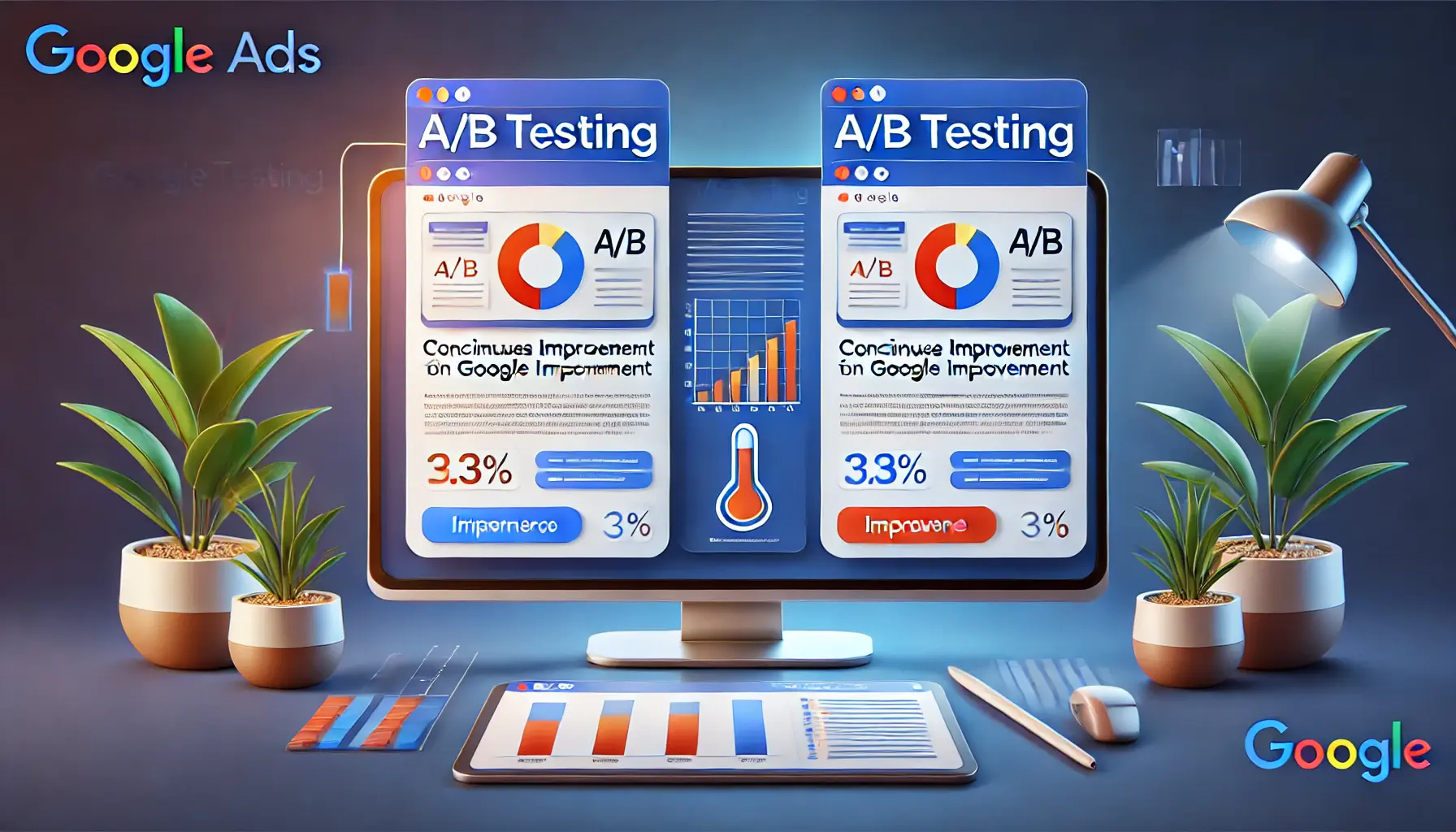
Visualizing the A/B testing process for continuous improvement in Google Ads.
A/B Testing for Continuous Improvement
A/B testing is a way to optimize your ads through data-driven decision-making.
It allows you to identify what works best and refine your campaigns for better performance.
Here’s how to conduct effective A/B testing:
- Test One Variable at a Time: Focus on elements like headlines, descriptions, call-to-action phrases, and target URLs.
- Set a Control Group: Test new variations against your existing ad to measure the impact of changes accurately.
- Monitor Key Metrics: Track metrics like Click-Through Rate (CTR) and Conversion Rate to gauge success.
- Iterate Based on Results: Use insights from tests to refine and improve your ads continuously.
- Run Tests for Sufficient Time: Ensure you collect enough data to make statistically significant decisions.
By implementing these strategies, you can craft Google Ads that not only attract attention but also drive conversions, delivering the business outcomes you desire.
Compelling ad copy and strategic use of ad extensions can significantly enhance the performance and ROI of your Google Ads campaigns.
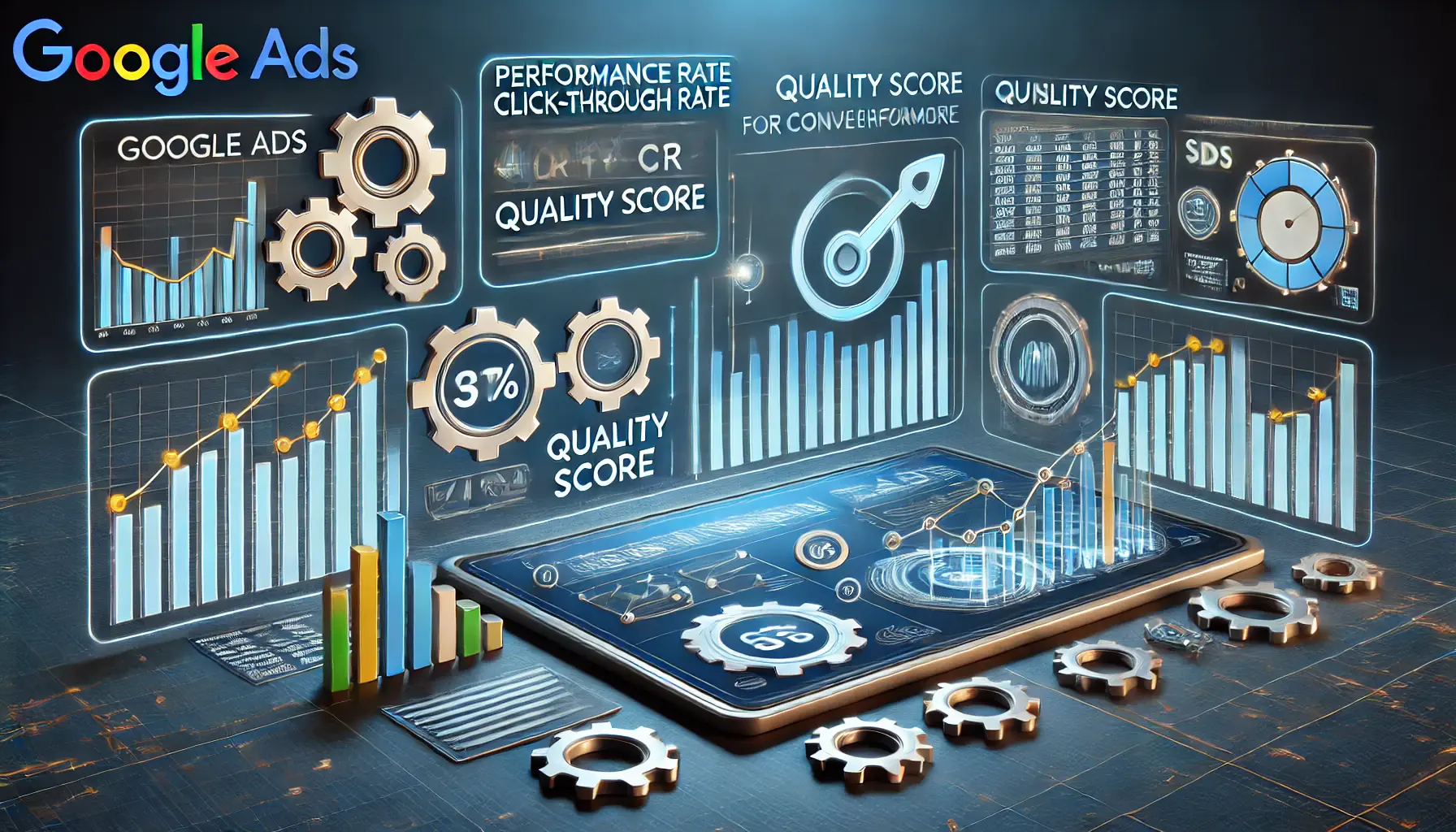
Visualizing the optimization process for improved Google Ads performance.
Optimizing Google Ads for Better Performance
Creating a Google Ads campaign is just the beginning.
To achieve sustained success, you need to continuously optimize your ads for better performance.
By fine-tuning your campaigns, analyzing performance data, and adjusting your strategy, you can improve key metrics like Click-Through Rate (CTR), Quality Score, and conversions.
Let’s explore the steps you can take to optimize your Google Ads effectively.
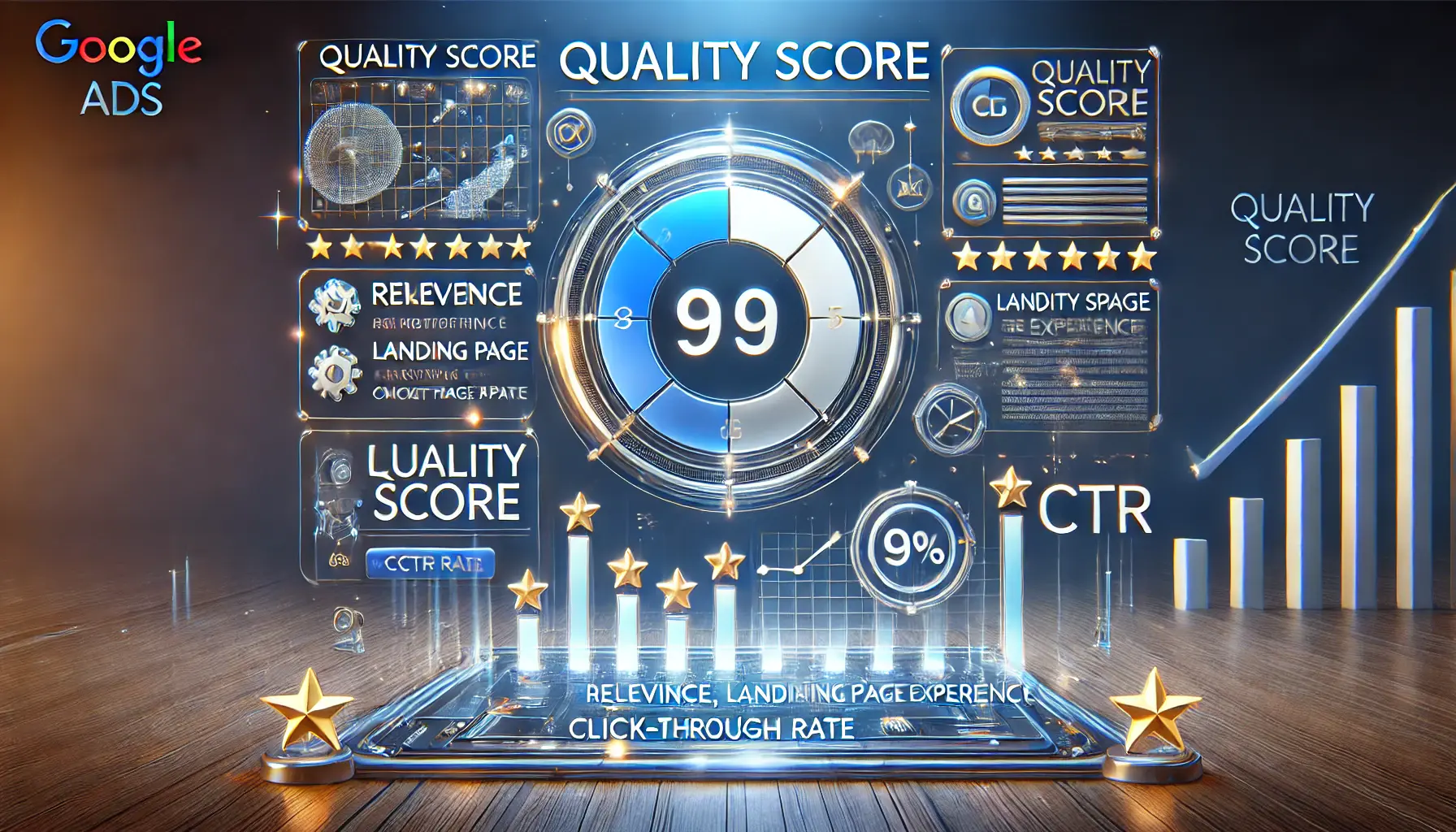
Visualizing the importance of Quality Score in Google Ads and its impact on ad performance.
Understanding Quality Score and Its Impact
Quality Score is a critical factor in the success of your Google Ads.
It measures the relevance and quality of your ads, keywords, and landing pages.
A higher Quality Score can lower your Cost-Per-Click (CPC) and improve your ad placement.
Here’s how to improve your Quality Score:
- Improve Ad Relevance: Ensure your ad copy aligns with your target keywords and audience intent.
- Optimize Landing Pages: Ensure landing pages are user-friendly, load quickly, and relate to the content of the ad.
- Pay Attention to CTR: A higher CTR shows users find your ad interesting and relevant.
- Refine Keyword Selection: Use keywords that best match user search intent and group them into tightly themed ad groups.
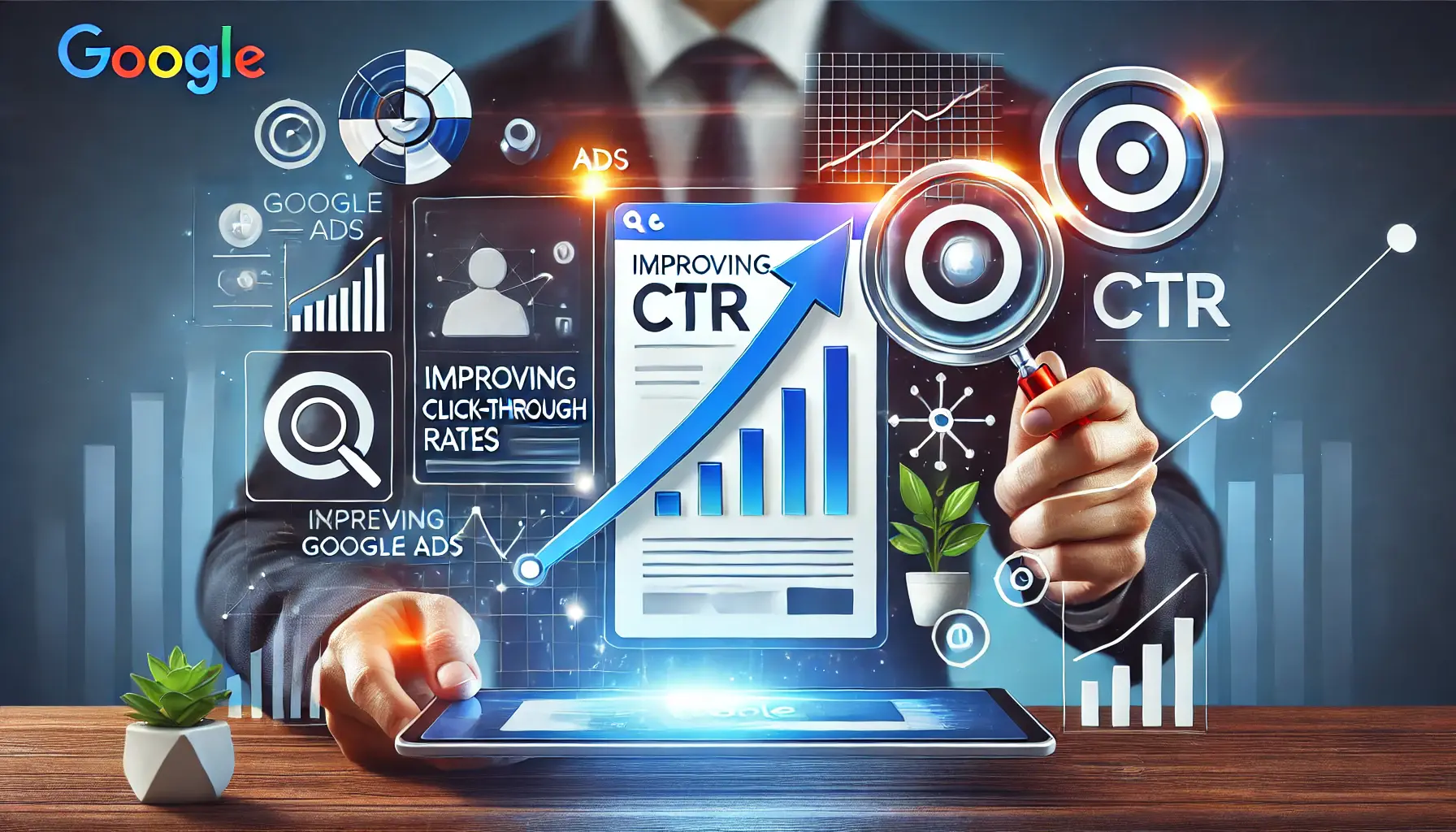
Visualizing strategies for improving click-through rates (CTR) in Google Ads.
Tips for Improving Click-Through Rates (CTR)
Click-Through Rate (CTR) is one of the key indicators of relevance and performance of your ads.
A higher CTR signifies that more users are clicking on your ad, highlighting its relevance and appeal.
To increase your CTR:
- Use Catchy Headlines: Construct headlines that immediately capture interest.
- Utilize Ad Extensions: Add sitelinks, callouts, and other extensions to provide more value and context.
- Include a Strong Call-to-Action (CTA): Direct users to take immediate action, such as “Shop Now” or “Learn More.”
- Test Different Variations: A/B test ad copy, visuals, and CTAs to identify what resonates most with your audience.
- Target Specific Audiences: Leverage audience targeting to deliver ads to the most relevant users.
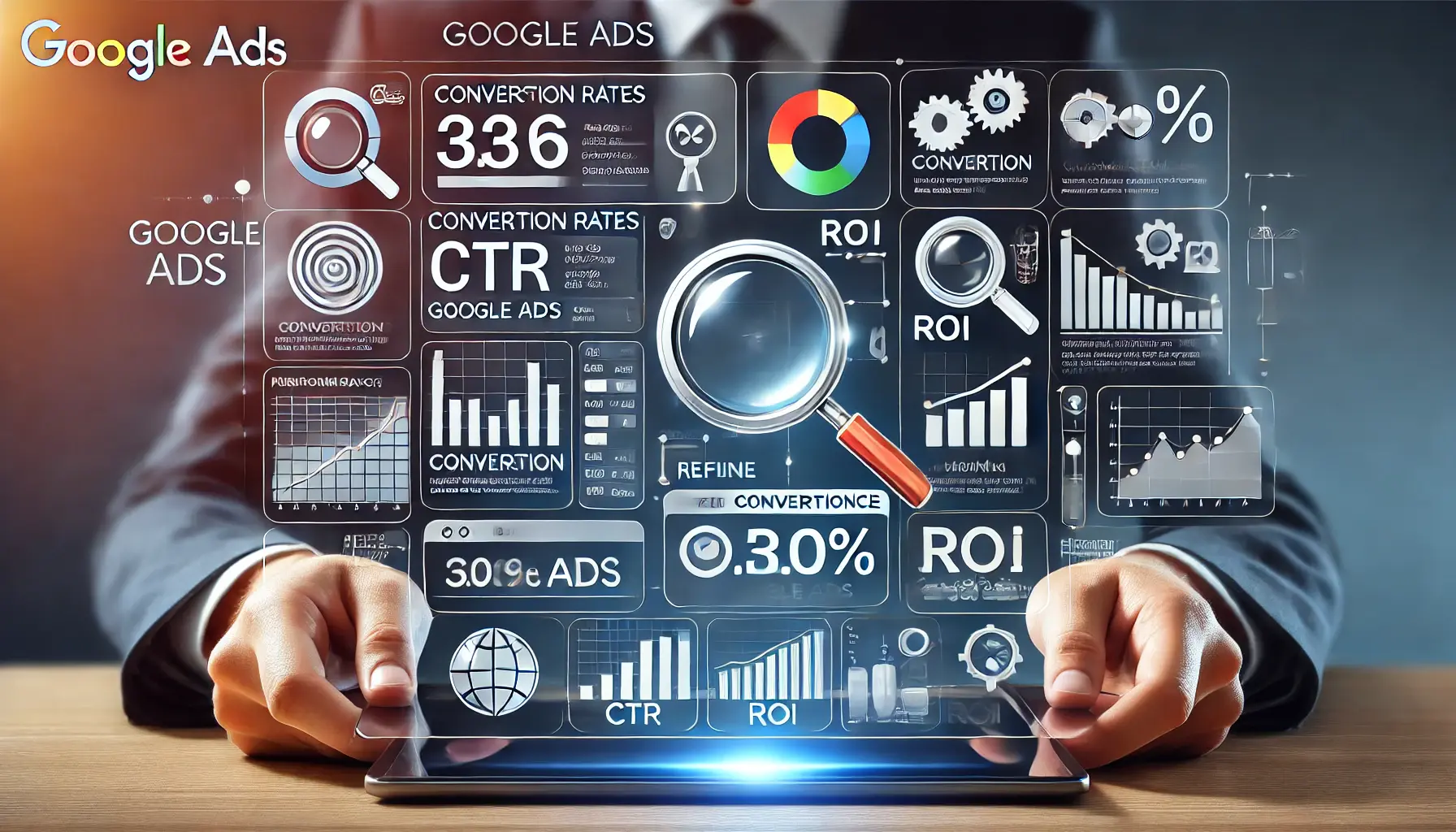
Visualizing the use of analytics to optimize and refine Google Ads campaigns.
Using Analytics to Refine Your Campaigns
Google Ads optimization revolves around data analysis.
Google provides robust tools to help you monitor and refine your campaigns using reports from Google Ads and Google Analytics.
Here’s how to optimize analytically:
- Track Major Actions: Monitor purchases, sign-ups, or downloads to measure the core success of your campaign’s goals.
- Discover High-Performing Ads: Identify ads with high CTR and conversions and replicate their strategies.
- Analyze Audience Insights: Understand demographics, interests, and behavior to tailor your ads further.
- Monitor Bounce Rates: High bounce rates on landing pages may indicate a need for better optimization.
- Use Custom Reports: Create reports that align with your specific goals to gain actionable insights.

Visualizing common mistakes in Google Ads optimization and areas for improvement.
Common Mistakes to Avoid in Google Ads Optimization
Even experienced marketers can make mistakes when managing Google Ads campaigns.
Avoid these common pitfalls to ensure optimal performance:
- Neglecting Negative Keywords: Failing to exclude irrelevant search terms can waste your budget on unqualified clicks.
- Ignoring Quality Score: Irrelevant ads and low-quality landing pages increase your costs and reduce effectiveness.
- Overlooking Mobile Optimization: Many users access ads on mobile devices, so ensure your ads and landing pages are mobile-friendly.
- Setting and Forgetting Campaigns: Regularly review and adjust your campaigns to adapt to changes in performance and competition.
- Focusing Solely on CTR: A high CTR is great, but prioritize conversions to maximize your return on investment.
By implementing these optimization strategies, you can ensure consistent delivery from your Google Ads campaigns and achieve your marketing goals effectively.
Continuous optimization is key to improving key metrics like Quality Score, CTR, and conversions in Google Ads.
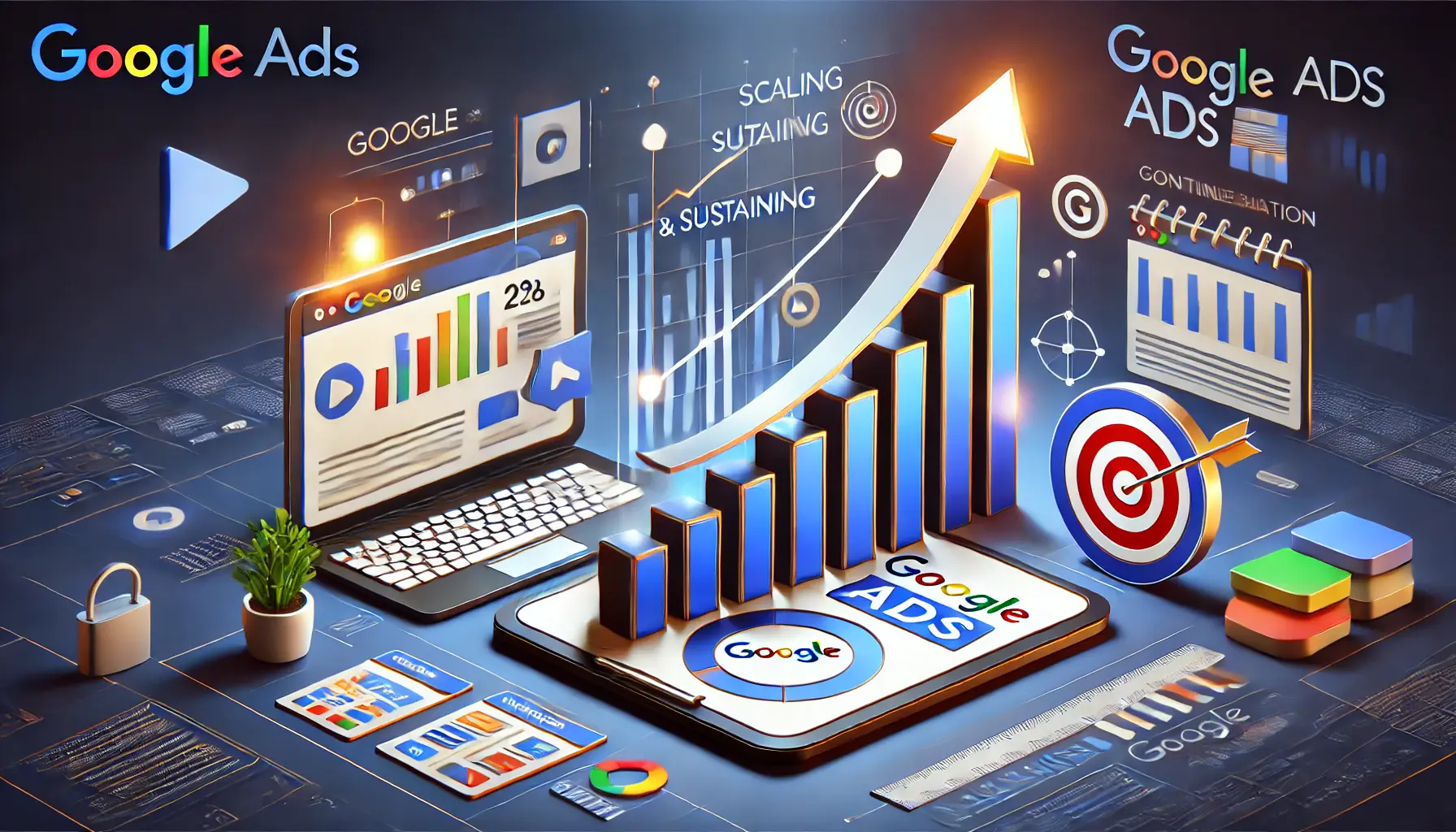
Visualizing the scaling and sustained success of Google Ads campaigns.
Scaling and Sustaining Google Ads Success
Once your Google Ads campaigns are performing well, the next step is to scale for maximum impact while maintaining a high ROI.
Scaling involves the strategic growth of your campaigns, adapting to seasonal trends, market changes, and audience growth.
Success is sustained through ongoing monitoring and optimization to ensure that ads continue to be effective.
Let’s dive into actionable strategies for scaling and sustaining your Google Ads success.
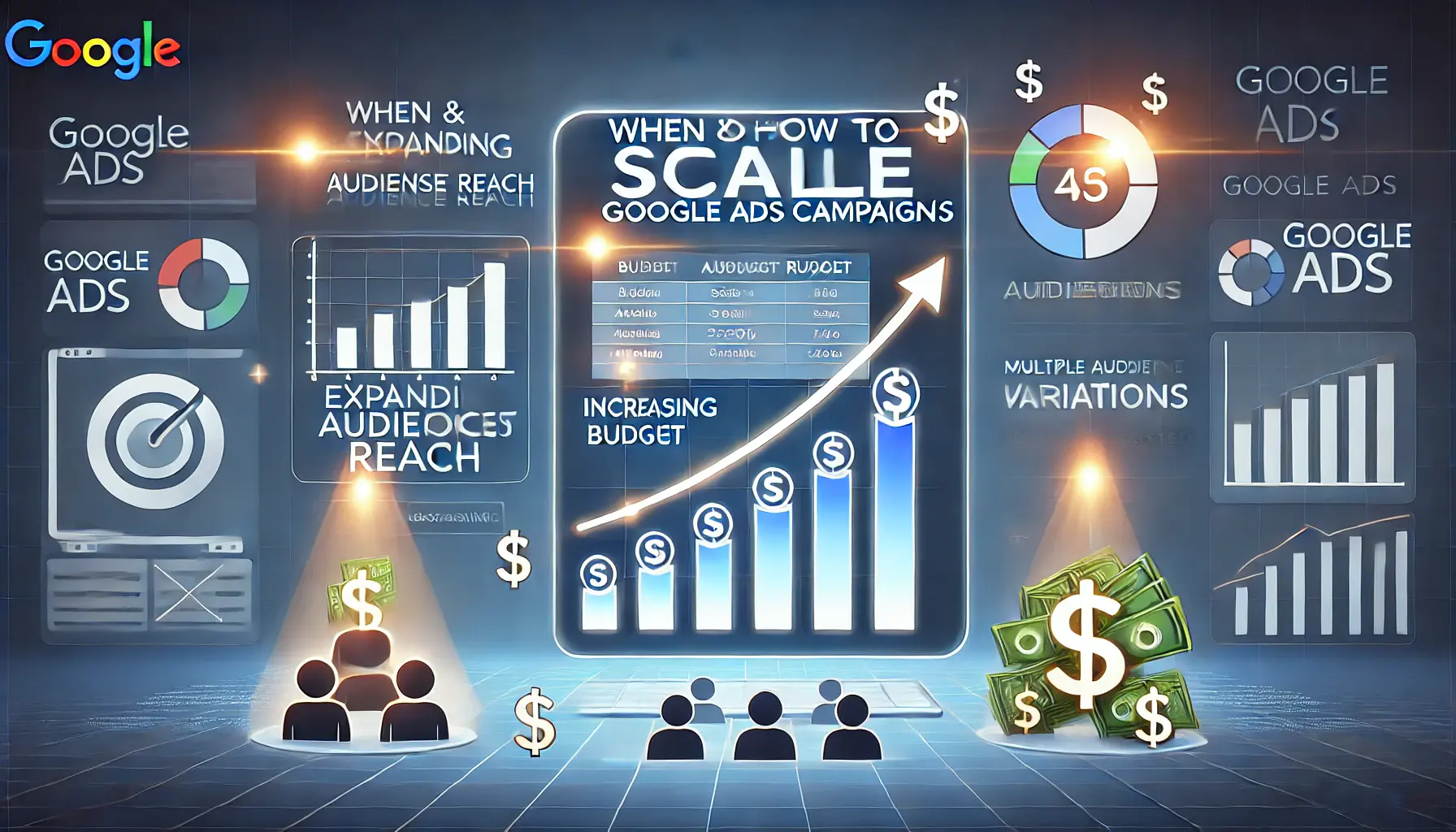
Visualizing the scaling process for Google Ads campaigns, including budget adjustments and audience expansion.
When and How to Scale Your Campaigns
Scaling your campaigns can bring significant rewards, but timing and strategy are critical.
Here’s how to scale effectively:
- Analyze Performance Metrics: Ensure your campaigns have a strong CTR, conversion rate, and Quality Score before scaling.
- Increase Budget Gradually: Incrementally raise your daily budget to test how your ads perform with a larger audience.
- Expand Keyword Lists: Add more long-tail keywords and variations to capture additional traffic.
- Replicate Successful Campaigns: Clone successful campaigns and adjust targeting parameters for new audiences.
- Leverage Automated Bidding: Use tools like Target ROAS or Maximize Conversions to optimize bids for scaling activities.

Visualizing the process of making seasonal adjustments to maximize ROI in Google Ads.
Seasonal Adjustments to Maximize ROI
Seasonal trends and holidays offer opportunities to capture increased consumer interest.
To maximize ROI during these periods:
- Plan Ahead: Identify the most relevant seasons or events for your business and create campaigns well in advance.
- Write Seasonal Ad Copy: Attract attention with time-sensitive messages and promotions.
- Adjust Budgets: Increase budgets during high-demand periods while monitoring performance closely.
- Retarget Audiences: Re-engage past visitors with tailored ads to boost conversions.
- Monitor Market Trends: Stay informed about changing consumer behavior and adapt your strategies accordingly.
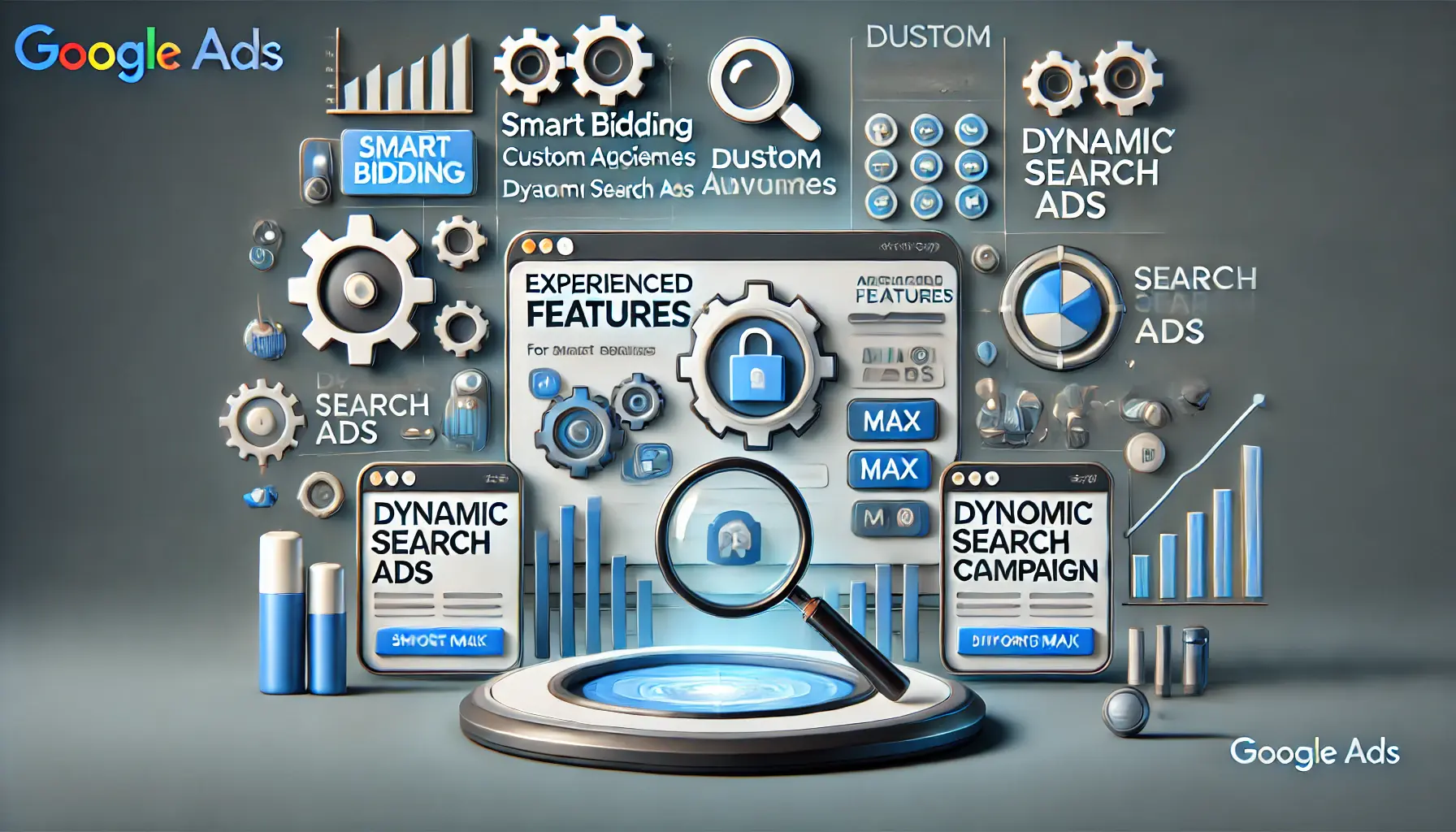
Visualizing advanced tools and features for expert Google Ads advertisers.
Advanced Features for Experienced Advertisers
Google Ads offers advanced features that can help experienced advertisers scale their campaigns and gain a competitive edge.
Here are some tools and tactics to explore:
- Smart Bidding: Use machine learning to optimize bids based on user behavior and campaign goals.
- Custom Audiences: Build highly targeted audiences using first-party data and detailed demographic filters.
- Dynamic Search Ads: Automatically generate ads based on website content to capture relevant searches.
- Performance Max Campaigns: Extend reach and serve more ads across all Google channels, including YouTube and Gmail.
- Data-Driven Attribution: Identify touchpoints that contribute most to conversions and allocate budgets accordingly.
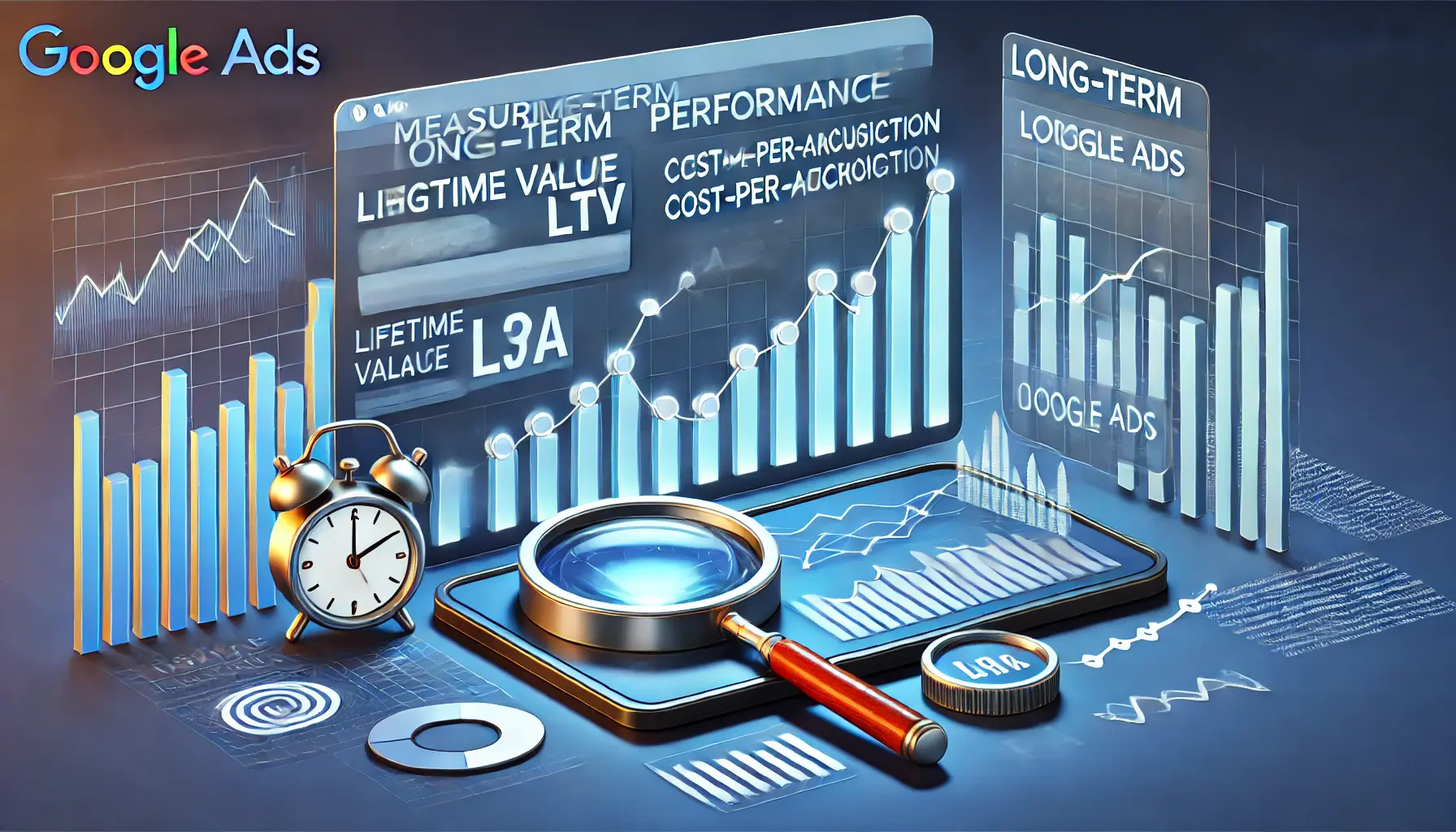
Visualizing the process of tracking long-term performance and key metrics in Google Ads.
Measuring Long-Term Performance Effectively
Sustaining success requires regular evaluation and adjustments to your campaigns.
Here’s how to measure long-term performance:
- Track Lifetime Value (LTV): Focus on customers who deliver long-term value rather than one-time conversions.
- Monitor Cost-Per-Acquisition (CPA): Ensure your cost to acquire customers aligns with your profitability goals.
- Use Cohort Analysis: Compare performance across different audience groups over time.
- Set Benchmarks: Establish performance benchmarks to identify areas for improvement.
- Review Ad Fatigue: Rotate ad creatives regularly to keep content fresh and engaging.
By scaling your campaigns thoughtfully and sustaining them with ongoing optimizations, you can achieve long-term success with Google Ads while continuously growing your business.
Scaling your campaigns requires strategic planning, while sustained success demands consistent monitoring and adaptation.

Visualizing the complete process of creating effective Google Ads that drive conversions.
Your Complete Guide to Creating Google Ads That Convert
Mastering the art of creating Google Ads that convert requires a combination of strategic planning, creativity, and consistent optimization.
Throughout this guide, we have explored the essential steps to ensure your campaigns deliver measurable results.
Let’s summarize the key insights that will help you achieve sustained success with Google Ads.

Visualizing the importance of starting with a strong foundation for creating effective Google Ads.
Start with a Strong Foundation
Building effective Google Ads begins with a solid understanding of the platform.
Choose the right campaign type based on your marketing objectives, define clear goals, and allocate a budget that aligns with your strategy.
Ensure that your keywords and ad groups are tightly themed for better targeting and relevance.

Visualizing the process of crafting compelling ads that drive conversions.
Craft Ads That Captivate and Convert
Writing compelling ad copy is central to attracting your audience’s attention.
Focus on highlighting benefits, using action-oriented language, and incorporating strong calls-to-action.
Leverage ad extensions like sitelinks and callouts to enhance visibility and provide additional value.
Remember to test different variations to refine your messaging and optimize performance.
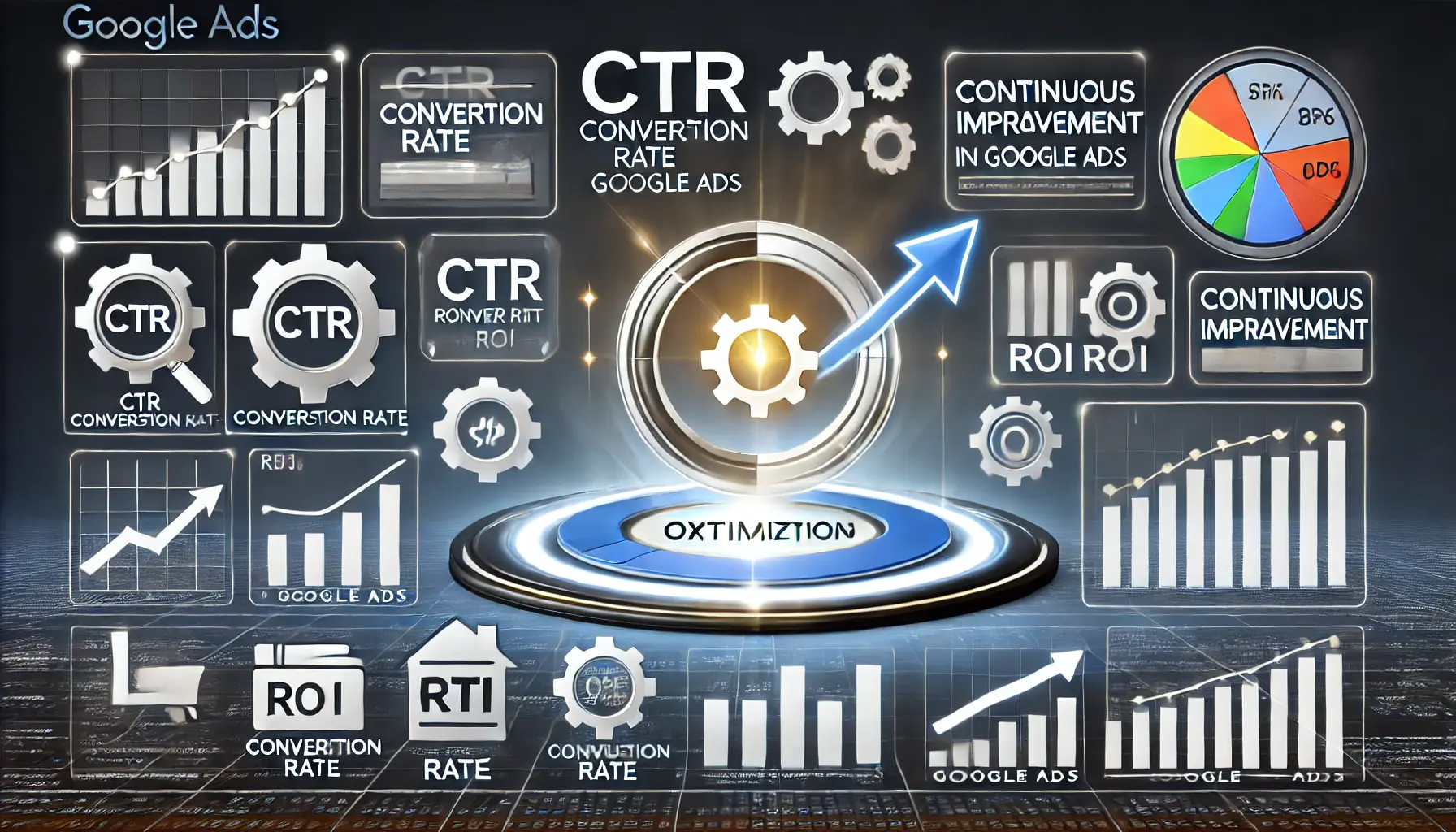
Visualizing the continuous optimization process for improving Google Ads performance.
Optimize for Continuous Improvement
To maximize the performance of your Google Ads, prioritize optimization.
Monitor metrics like Quality Score, Click-Through Rate (CTR), and conversions to identify areas for improvement.
Use Google Analytics to analyze data, refine your targeting, and adjust your strategy as needed.
Avoid common pitfalls, such as neglecting negative keywordsTerms that prevent ads from showing for specific searches to improve targeting. or ignoring mobile optimization.

Visualizing the process of scaling and sustaining long-term success in Google Ads.
Scale and Sustain Your Success
Scaling your campaigns allows you to reach a broader audience while maintaining high ROI.
Gradually increase budgets, expand keyword lists, and replicate successful campaigns to achieve growth.
Use advanced tools like Smart BiddingThe process of setting a maximum cost you’re willing to pay for a click or impression on your ad. and Performance Max campaigns to optimize and extend your reach.
Stay adaptable by adjusting to seasonal trends and evolving market demands.
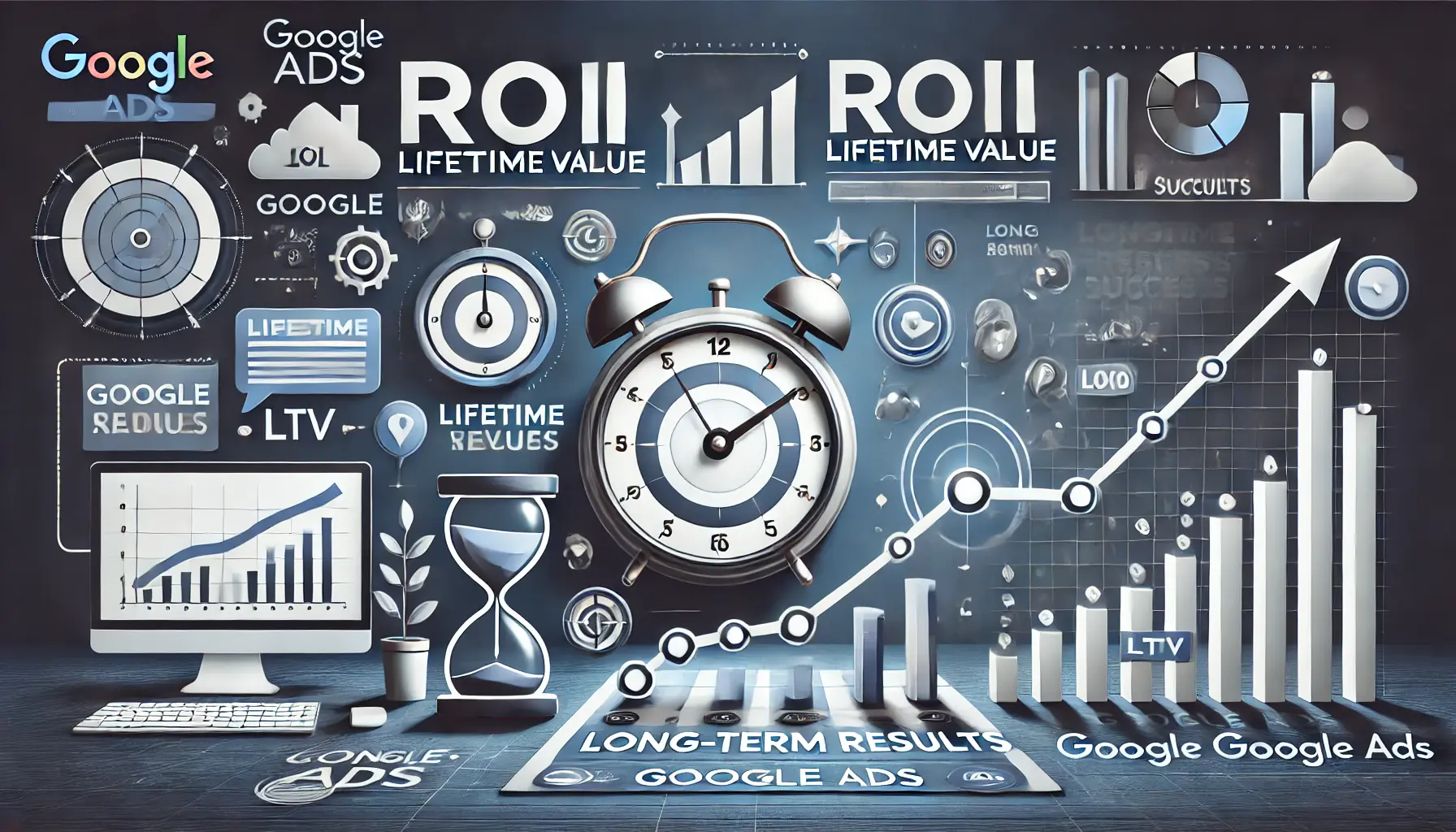
Visualizing the process of achieving long-term results with Google Ads.
Achieve Long-Term Results
Success with Google Ads is an ongoing process that requires constant work and analysis.
Monitor Lifetime Value (LTV), track your Cost-Per-Acquisition (CPA), and establish benchmarks to compare performance across different periods.
Rotate ad creatives on a regular schedule to avoid creative fatigue and keep your content fresh.
Continuous learning and improvement will help you stay ahead of the competition and continue growing your business over time.
With the knowledge and tactics available in this guide, you are well-equipped to create Google Ads that are both attention-grabbing and effective at driving conversions.
Whether you’re just starting or looking to scale your efforts, these principles will help you achieve your advertising goals and maximize your return on investment.
This guide provides actionable steps to create, optimize, and scale Google Ads campaigns that convert effectively.
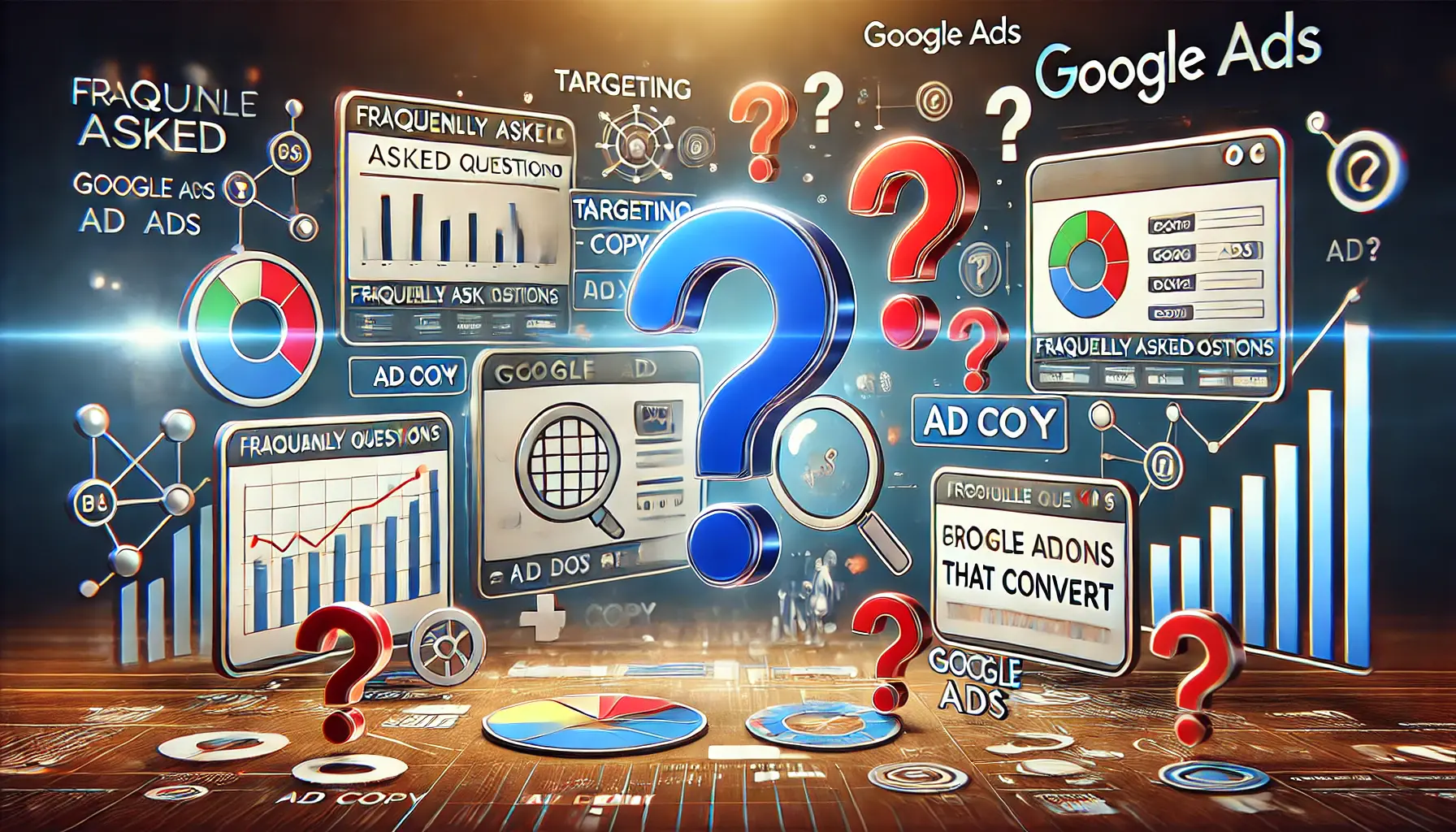
Visualizing the key questions and concerns in creating Google Ads that convert.
Your campaigns can be managed by an agency specialized in Google Ads, check out our service page.
Frequently Asked Questions About Creating Google Ads That Convert
Creating Google Ads that convert can often raise specific questions.
Below, we answer some of the most frequently asked questions to help you better understand the process and strategies for crafting successful Google Ads campaigns.
The most critical factor is relevance.
Ensure your ad copy, keywords, and landing pages align with user intent to achieve better Quality Scores and higher conversions.
Start with a modest budget and test performance.
Gradually increase your spend based on results, aligning it with your marketing goals and expected return on investment.
Ad extensions enhance your ads with additional information, like links or callouts.
They improve visibility, increase click-through rates, and provide users with more value.
Focus on ad relevance, improve landing page experience, and maintain a strong CTR.
Regular optimization of keywords and ad copy is also essential for improving Quality Score.
Use tools like Google Keyword Planner to identify high-intent, low-competition keywords.
Group related keywords into tightly themed ad groups for better targeting and performance.
A/B testing helps identify which ad elements perform best.
It enables you to refine your ads continuously, leading to improved click-through rates and conversions over time.
Scale your campaigns when they consistently show strong CTRs, high conversion rates, and good ROI.
Gradually increase budgets and expand targeting to reach broader audiences.
Use Google Ads reports and Google Analytics to monitor metrics like CTR, conversions, and ROI.
Set benchmarks to evaluate performance and identify areas for improvement.
Manual bidding allows full control over CPC, while automated bidding uses algorithms to optimize bids based on your campaign goals, such as maximizing conversions or targeting ROASReturn on Ad Spend, a metric that measures revenue generated per dollar spent on ads..













